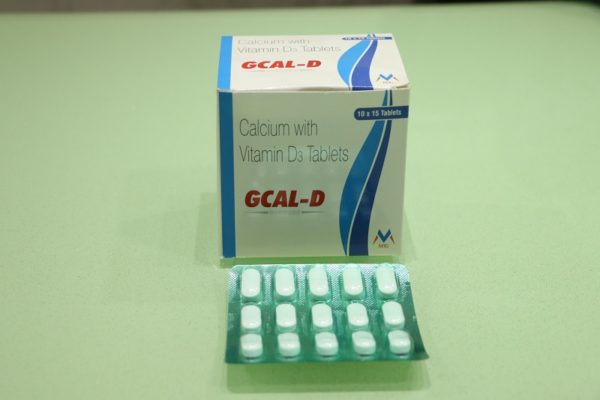GCAL-D
COMPOSITION: CALCIUM WITH VITAMIN D3
- Reviews (0)
- INDICATION
- DESCRIPTION
Be the first to review “GCAL-D”
CALCIUM & VITAMIN D DEFICIENCY OSTEOPOROSIS
Calcium Carbonate Vitamin D3 information
Is a dietary supplement. It works by providing extra calcium to the body. Antacids are taken by mouth to relieve heartburn, sour stomach, or acid indigestion. They work by neutralizing excess stomach acid. Some antacid combinations also contain simethicone, which may relieve the symptoms of excess gas. Antacids alone or in combination with simethicone may also be used to treat the symptoms of stomach or duodenal ulcers. With larger doses than those used for the antacid effect, magnesium hydroxide (magnesia) and magnesium oxide antacids produce a laxative effect. The information that follows applies only to their use as an antacid. Some antacids, like aluminum carbonate and aluminum hydroxide, may be prescribed with a low-phosphate diet to treat hyperphosphatemia (too much phosphate in the blood). Aluminum carbonate and aluminum hydroxide may also be used with a low-phosphate diet to prevent the formation of some kinds of kidney stones.
Calcium carbonate is a calcium supplement that is used in deficiency states and as an adjunct in the prevention and treatment of osteoporosis. Vitamin D3 is a fat-soluble sterol, it aids in the regulation of calcium and phosphate homeostasis and bone mineralisation.
Absorption Calcium carbonate: About 15-25% gets absorbed in the GI tract. Converted to calcium chloride by gastric acid. Vitamin D: Well-absorbed in the GI tract in the presence of bile.
Metabolism Vitamin D: Undergoes hydroxylation in the liver and kidney to form the active metabolite, 1,25-dihydrocolecalciferol.
Excretion Vitamin D and metabolites are mainly excreted in the bile and faeces.
Constipation, flatulence, nausea, abdominal pain and diarrhoea. Pruritus, rash and urticaria.
Overdosage Overdose can lead to hypercalcaemia. Symptoms: Anorexia, thirst, nausea, vomiting, constipation, abdominal pain, muscle weakness, fatigue, bone pain, nephrocalcinosis, nephrolithiasis, mental disturbances, polydipsia, polyuria and cardiac arrhythmias (severe cases). Extreme hypercalcaemia may lead to coma and death. Irreversible renal damage and soft tissue calcification may occur as a result of prolonged hypercalcaemia. Treatment of hypercalcaemia: Rehydrate and discontinue calcium supplement and any treatment with thiazide diuretics, lithium, vitamin A or D and cardiac glycosides. Monitor serum electrolytes, renal function and diuresis.
Impaired calcium absorption in achlorhydria which is common in elderly. Increased risk of hypercalcaemia and hypercalciuria in hypoparathyroid patients receiving high doses of vitamin D. Caution when using in patients with history of kidney stones. Renal impairment; frequent monitoring of serum calcium and phosphorus is recommended.
May affect the absorption of tetracycline when used together. Concurrent use with systemic corticosteroids may reduce calcium absorption. Thiazide diuretics may decrease urinary excretion of calcium. Concurrent use with ion-exchange resins may reduce GI absorption of vitamin D. Hypercalcaemia may increase the toxicity of cardiac glycosides during treatment with calcium and vitamin D, monitor ECG and serum calcium levels. Bisphosphonate or sodium fluoride should be given at least 3 hr before calcium-containing preparations.
Food Interactions: Foods that are rich in oxalic acid (e.g. spinach and rhubarb) and phytic acid (e.g. whole cereals) may reduce calcium absorption by formation of insoluble calcium salts, thus calcium products should not be taken within 2 hr of eating such foods.






Reviews
There are no reviews yet.